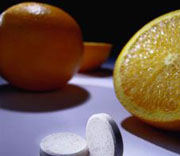|
Vitamin |
Needed For |
Good Sources |
|
Vitamin A
(and beta-carotene)
|
Healthy skin, strong teeth and bones in children, maintaining resistance to infection, normal growth, cell structure, normal eyesight
|
Fish liver oils, liver, dairy products (vitamin A); carrots, dark-green leafy vegetables (beta-carotene)
|
|
Vitamin B-1
(thiamine)
|
Use of carbohydrates in the body, digestion and appetite, normal function of nervous system
|
Whole grains, brown rice, beans, peas, organ meats, lean pork, seeds/nuts
|
|
Vitamin B-2
(riboflavin)
|
Normal growth, formation of certain enzymes, cellular oxidation, prevention of sores and swelling of mouth and tongue
|
Dairy products, meats, poultry, fish, green vegetables (broccoli, turnip greens, asparagus, spinach)
|
|
Vitamin B-3
(niacin)
|
Activities of enzymes in the body's use of carbohydrates and fats, detoxification of pollutants and alcohol, nervous and digestive system functions, production of sex hormones, healthy skin
|
Lean meats, fish, poultry, whole grains
|
|
Vitamin B-6
(pyridoxine)
|
Use of amino acids in the body, making hemoglobin
|
Meats, whole grains, wheat germ, brewer's yeast
|
|
Vitamin B-12
|
Nervous system functions, normal development of red blood cells, production of genetic material in cells, effective use of carbohydrates and folic acid from foods
|
Fish, dairy products, organ meats, beef, pork, eggs
|
|
Biotin
|
Activities of enzymes needed to break down fatty acids in carbohydrates, ridding the body of wastes from breakdown of proteins
|
Nuts, whole grains, vegetables, fruits, milk, organ meats, brewer's yeast
|
|
Folic acid
|
Important metabolic processes in the body, growth, reproduction, production of red blood cells
|
Green leafy vegetables, oranges, beans, peas, rice, eggs, liver
|
|
Pantothenic acid
|
Production of certain hormones, activities of enzymes in the body's use of fats and carbohydrates, use of vitamins, normal growth, nervous system functions
|
Organ meats, eggs, whole grains, brewer's yeast
|
|
Vitamin C
(ascorbic acid)
|
Healthy skin, bones, teeth, gums, ligaments, and blood vessels; immunity to disease; wound healing; absorption of iron from the digestive tract
|
Citrus and other fresh fruits, fresh vegetables
|
|
Vitamin D
|
Strong bones; regulation of the absorption of calcium and phosphorus from the digestive tract
|
Fatty fish, liver, eggs, fortified milk
|
|
Vitamin E
|
Normal brain function, formation of red blood cells, maintaining some enzymes, normal cellular structure, protection against pollutants
|
Whole grains, vegetable oils, green leafy vegetables, eggs
|
|
Vitamin K
|
Blood clotting
|
Green leafy vegetables, dairy products
|
See on other sites:
MedlinePlus
https://medlineplus.gov/vitamins.html
Vitamins
National Institutes of Health - Office of Dietary Supplements
http://ods.od.nih.gov/
Dietary Supplement Fact Sheets
Updated August 2016 |
|



